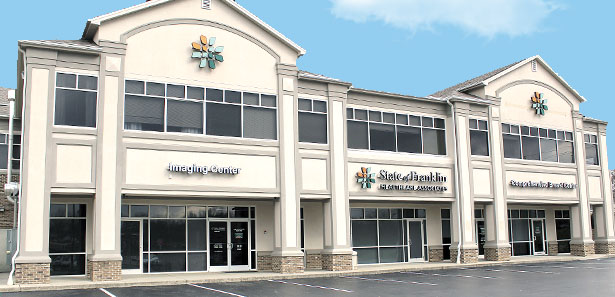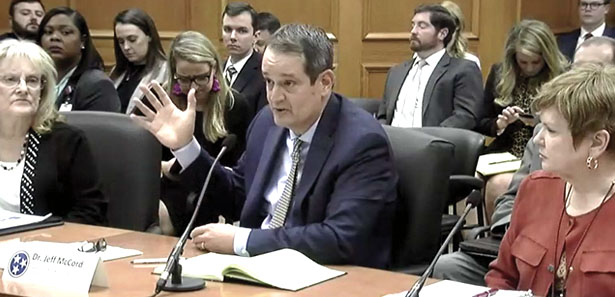Holston Medical Group (HMG) garnered headlines in the region in 2020 for taking part in the Pfizer COVID vaccine clinical trial. But behind the headlines, HMG was dealing with COVID in its own business model, working to implement a telehealth system in a “build the plane while we’re flying it” environment. At the same time, HMG managed to introduce new service lines and add 15 new providers and 128 new employees. The Business Journal visited virtually with HMG Chairman and CEO Scott Fowler in late January 2021 to look back and to look ahead. What follows is a transcript of that conversation, edited for space.
The Business Journal: HMG logged a total of 622,464 encounters in 2020. Can you break that down in terms of how many of those encounters were face-to-face, how many were done with remote technology and how that compares with 2019?
Dr. Scott Fowler: Sure. Our overall visits were down a little bit from the previous year, probably about 5 percent, which is, I think, remarkable considering COVID. So, when COVID first hit back in March or so, our non-face-to-face visits were really very tiny. We really didn’t have the technology and culture in place to do televideo visits.
But, in March we increased to 800-900 visits a month in telehealth. So, that really allowed us to see a reduction of almost 800 visits a month in our offices and that was wonderful. We did that for about three months at that level and then as COVID started to to wane and it was time to get those patients obviously in for face-to-face visits because a lot of that was things that we could do over the phone but it was also, over time things that obviously needed to be followed up with face-to-face visits.
At that point, telehealth visits dropped over a month or two down to about 100 a month and they’ve stayed at about 100 a month consistently since then. So, we’ve got telehealth visits in place now and we certainly can use them. We’ve begun using them a little more over the last month or so, but they’re around a hundred a month.
BJ: When you decide who’s going to be seen via telehealth versus in-person, are the criteria now strictly COVID-based at this point? It’s somebody who says well yes to one of the questions that you’re always supposed to say no to, then you say well let’s do this one by a phone?
SF: Well there are some black and white kind of lines there but mostly if it can be done by phone safely and you can achieve the same purpose – and remember some of these things the patient really does need to be seen face-to-face say every three months if they’re a patient with multiple diseases, but you can certainly see them safely for one month – then we might see a patient who would qualify for a face-to-face and a telehealth visit just because we’re trying to protect them from going out. So, it really isn’t, I think, at least the way we do it, as black and white as people think.
For the most part we talk to the patients. There are some technology barriers that some patients have that require that we bring them in just because maybe they don’t have internet service or something like that. But, if we can do it over a telephone, we do. If we need televideo, we do that and there really isn’t a black and white. It’s more the physician who knows the patient and has the records usually, thinking about it, talking to the patient about what their preferences are, but we have found out that for patient care purposes really the telehealth thing is quite a service to be able to provide to your patients.
BJ: HMG has a total of 242,991 active patients today, so what’s the net change from where you were a year ago at this time?

SF: We’re growing. We’re certainly growing as a practice, and of course as you grow with your provider numbers you grow with your patient numbers too for the most part. So, over several years we’ve been in the 225 to 230 range, somewhere in there. So we’ve seen a little bit of growth, but I wouldn’t say more than 5 percent growth in just patient numbers.
BJ: What drove the the 15 new providers and 128 new employees? Was it the new service lines or was it just organic growth in areas you were already serving?
SF: There was some expansion. I think we realized that especially in some of the rural areas we need to grow. We also needed to move more of our work outpatient. That’s just a consequence, as you know, of the move to value-based medicine. Especially with our large population of Medicare patients, it makes sense to move as many services as we can out. So, that accounts for most of the growth. Because of that same business model, we have developed outpatient diagnostics and surgery centers and those certainly add to those numbers as well.
BJ: Did the the COVID outbreak affect your scheduling of bringing online the new service lines?
SF: Yes, it did. It affected our relationship with dialysis quite a bit. The opening of that service line slowed down but it’s back on track now. That was a difficult time for us to be making a new service line in those areas. I think for surgery centers it probably didn’t slow us down very much because as you know, the outpatient surgery centers are safe places. Going and having your elective surgeries in the hospital was a problem for the hospitals and also for the patients. We also had allocations for our PPE and we could do outpatient testing, so we were sophisticated enough for those service lines to go forward. So, overall we were able to move those service lines forward at about the pace we thought they should move.
BJ: What about the pace of your clinical studies?
SF: We did the Pfizer COVID study. The Pfizer study on the vaccine was done at HMG, at least for this region, so we actually got that study. We also got quite a few other studies. In the years prior to 2020 studies had started to slow down. The pharmaceutical companies were breaking the studies up so there were some changes going on in the research community. I think 2020 – with the reinvigoration of research around the idea of the COVID and having gotten that study for our region – I think that bodes pretty well for our research department. We’ve been able to keep our study numbers up here, so we’re real happy with that.
BJ: In terms of dollars and cents, how is your practice revenue and overall how did you net out in 2020?
SF: Our fee-for-service revenue, as you can expect, dropped a little bit. It tends to follow visit numbers, but it was made up for by our outpatient facilities – surgery centers and diagnostic centers. We have free-standing diagnostic centers that are contracted independently and because they contract independently, we have the ability over there to keep the prices at a point where we can keep the volumes like we need to keep them to be successful. So, those made up for revenues on the fee-for-service side, where you get paid for what your amount of work is or your volume is. So, overall we held our own despite COVID. Obviously, there were some payments from the government that came in. If you were within a few percent of your fee-for-service revenue, some of the government payments made that even out. So, I would say overall that fee-for-service is kind of a net wash for the year for us.
Even though we had some decreased visit numbers on fee for value, certainly in Medicare this region has moved very, very aggressively. We have the OnePartner Health Information Exchange which has 98 percent of the patient’s records that we see from all over. Wherever they go, we have access to that. Those contracts have grown significantly in terms of risk. So, we’re full risk on those contracts as are other groups. And what that results in is another form of income that’s not based on how many patients you see or what you visit numbers are. It’s really based on a measure of quality. How well did you do? Did you keep your patients with blood pressure issues in range? Did your diabetics actually do better with their hemoglobin A1Cs or their sugar levels? It measures those types of things. Did people get flu shots and did their pap smears get done?
But, it also measures how well you adapted to cost savings, so the overall benchmarking for what should be spent on a patient versus were you able to utilize the same quality or higher quality services and coordinate? That’s why I mentioned OnePartner. The coordination of patient care across various different stakeholders is critical to that. So, we saw our fee-for-value component of our overall total revenue increase significantly in 2020, and that was because of investments made literally all the way back to 2010.
HMG has been consistently investing millions of dollars – we probably have invested well over $20 million in the last five or six years in building the types of infrastructure that allows us to manage these patients better.
So, it was a very good year for HMG. We had a lot of those investments that we’ve made show up at a time when quite frankly we needed it because the fee-for-service model was under some attack both from the contracting side of what you get paid for what you do, and also from COVID, obviously, in just the dynamics of how you manage and see patients.
BJ: So, when you say ‘increased significantly,’ what does ‘significant’ mean in terms of dollars and cents?
SF: So, if you did it in terms of EBITDA or something like that, you’re talking about 25 percent.
BJ: Let’s turn to what in the language of investment press releases and earnings calls is ‘forward-looking statements.’ Are there practices that you started into in 2020 out of necessity that are turning out to make sense as you move forward? And, what kind of timeline are you on in terms of working back towards normalcy – which we assume starts with vaccine availability?
I think the IT infrastructure, the interconnectedness and the ability to use that interconnectedness to coordinate and get patients better service – and hopefully, that includes taking some of the redundancy out of the way they access the system now – those are all part of our future.
SF: Yes, so we are obviously pushing to get herd immunity across the region as quickly as we can. We’re also watching carefully to address how this is going to impact the future of healthcare. For instance, is this going to be a recurring problem?
It certainly has offered changes that we would have preferred anyway, and I’ve mentioned telehealth specifically. I think it’s just better for patients to have access to their doctors in a way that makes sense. From a value point of view, telehealth is lower cost. There’s much less overhead associated with it, if you can do the same kind of care. Like I say, you can’t do everything that way. You do have to see patients in person and you do have to have relationships with them. So, we think that telehealth will remain inside practices where doctors and patients are connected to each other.
That’s not to say that there won’t be national companies that you can pick up the phone and call somebody you’ve never met before or maybe text them and get some medicine back. We know that’s going to happen because it’s advertised on TV and it is happening.
But in terms of actually taking care of patients, we think that telehealth would just be another tool for providers and patients in the local regions where they actually live and can be seen to be taken care of.
So, we expect our telehealth to be a consistent future part of our practice and we hope it will be. We’ll have to see how the patients do, because it’s about them in the end, but we’re certainly trying to keep our numbers up and make sure that patients who would prefer a telehealth appointment and qualify get it.
So, that’s the first thing. Secondly, our plan to move as much of our services to higher quality lower cost environments means that we need to develop those environments where they don’t currently exist. So for instance, we have a diagnostic center that’ll open in Johnson City mainly because there wasn’t an independent diagnostic center there that was multimodality that we could use for our practice that’s over there. So, we’ll continue that. We’ve been doing that for a while. That’s the same reason we have the surgery center, because there weren’t independently contracted surgery centers. Those are all good things for patients, and I think part of our business model.
Value-based care, we believe will go from the 25 to 30 percent revenue mark up to about 50 percent, so we’re expecting that in the next two to three years, unless there’s some major change that happens to the healthcare system vis a vis CMS or something like that. So, we’ll continue to build that.
I think the IT infrastructure, the interconnectedness and the ability to use that interconnectedness to coordinate and get patients better service – and hopefully, that includes taking some of the redundancy out of the way they access the system now – those are all part of our future.
I think, forward looking from purely a financial point of view, we expect revenues to grow possibly another 20 percent over where we are now. We’re looking at 20-25 percent over the next several years in the fee-for-value space.




